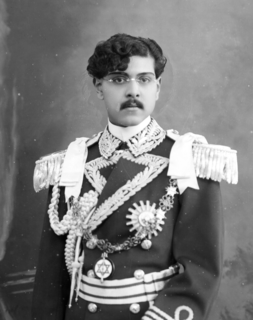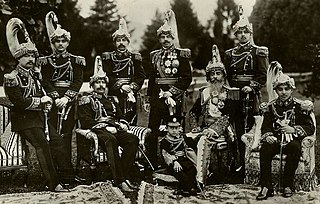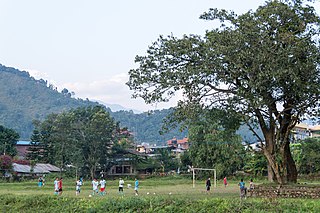
Tribhuvan Bir Bikram Shah was King of Nepal from 11 December 1911 until his death. Born in Kathmandu, the capital city of Nepal, he ascended to the throne at the age of five, upon the death of his father, Prithvi Bir Bikram Shah, and was crowned on 20 February 1913 at the Nasal Chowk, Hanuman Dhoka Palace in Kathmandu, with his mother acting as regent. At the time of his crowning, the position of monarch was largely ceremonial, with the real governing power residing with the Rana family.

Mahendra Bir Bikram Shah Dev was King of Nepal from 1955 to 1972. Mahendra was born on 11 June 1920 to King Tribhuvan of Nepal. Although Tribhuvan was nominally king since 1911, the royal family had been held captive in Narayanhity Palace since the rise of the prominent Rana dynasty. In 1940, he married Indra Rajya Lakshmi Devi, daughter of General Hari Shamsher Jang Bahadur Rana. Mahendra had three sons, Birendra, Gyanendra, and Dhirendra and three daughters Shanti, Sharada, and Shobha. Crown Princess Indra died in 1950. In 1952, Mahendra married Indra's younger sister, Ratna Rajya Lakshmi Devi. This marriage produced no children as King Mahendra had married on the condition his personal life should not hinder his national duties and the queen agreed to be childless.

Prithvi Bir Bikram Shah was King of Nepal from 1881 until 1911. Among the most notable events of his reign were the introduction of the first automobiles to Nepal, and the creation of strict water and sanitation systems for much of the country. King Prithvi's eldest child was Princess Royal Lakshmi Rajya Lakshmi Devi, who was married to Field Marshal Kaiser Shamsher Jang Bahadur Rana. She was made the Crown Princess and was heir to Nepal's throne until she was in her late teens, when her brother King Tribhuvan Bir Bikram Shah Dev was born. Until then King Prithvi only had four daughters and four from another wife.

Aishwarya Rajya Lakshmi Devi Shah was the Queen of Nepal from 1972 to 2001, also referred as Bada Maharani (बडामहारानी). She was the wife of King Birendra and the mother of King Dipendra, Prince Nirajan, and Princess Shruti. She was the eldest among the three daughters of late General Kendra Shumsher Jang Bahadur Rana and Shree Rajya Lakshmi Devi Shah in Lazimpat Durbar, Lazimpat, Kathmandu.

Field-Marshal Shree Shree Shree Maharaja Sir Mohan Shumsher Jung Bahadur Rana, GCB, GCIE, GBE was the prime minister and foreign minister of Nepal from 30 April 1948 until 12 November 1951.

Princess Shruti Rajya Lakshmi Devi Shah was the daughter of King Birendra and Queen Aishwarya, and sister of King Dipendra and Prince Nirajan.

Rana dynasty is a Chhetri dynasty that imposed totalitarianism in the Kingdom of Nepal from 1846 until 1951, reducing the Shah monarch to a figurehead and making Prime Minister and other government positions held by the Ranas hereditary. They claimed Kshatriya status themselves. Rana dynasty is historically known for the iron-fisted rule. This changed after the Revolution of 1951 with the promulgation of a new constitution, when power shifted back to the monarchy of King Tribhuvan.

Football is one of the major and the most popular sports of Nepal. It is governed by the All Nepal Football Association (ANFA). The present acting president of ANFA is Karma Kshiring Sherpa. The current top domestic league is the Martyr's Memorial A Division league. The Nepal national football team represents Nepal in all international competitions.

Field Marshal Sir Kaiser Shumsher Jang Bahadur Rana, GBE was a field marshal in the Royal Nepalese Army. He was the third son of Maharaja Sir Chandra Shamsher Jang Bahadur Rana, GCB, GCSI, GCMG, GCVO the fifth Prime Minister of Nepal of the Rana dynasty and Bada Maharani Chandra Loka Bhaktha Rajya Lakshmi. He was the younger brother of Shree Tin Maharaja Sir Mohan Shamsher Jang Bahadur Rana and Sir Baber Shamsher Jang Bahadur Rana.

Sir Baber Shumsher Jung Bahadur Rana, GCVO, GBE, KCSI, KCIE was a member of the Rana dynasty who served as the Minister of Defence of Nepal in 1951. A prominent member of the Rana oligarchy, he fought valiantly in the First World War. He was the second son of Maharaja Sir Chandra Shamsher Jang Bahadur Rana and Bada Maharani Chandra Loka Bhakta Lakshmi Devi. He was the younger brother of Maharaja Sir Mohan Shamsher Jang Bahadur Rana and older brother of Field Marshal Sir Kaiser Shamsher Jang Bahadur Rana.

Field-Marshal Maharaja Sri Teen Chandra Shumsher Jung Bahadur Rana was the Prime Minister of Nepal from the Rana dynasty. He served in this capacity from 27 June 1901 to his death in 1929, after he successfully deposed his liberal and reformist brother Dev Shamsher. Although generally perceived as despotic and conservative, he is credited with several reforms including the abolition of slavery and the Nepal-Britain Treaty of 1923, which recognized Nepal as an independent nation and an ally of Britain.
Commander in Chief Kiran Shamsher Jang Bahadur Rana (1916–1983) was a Nepalese army officer. He served as the Royal Nepalese Army's Commander-in-Chief from 1951–1956 and as the Nepalese ambassador to the United Kingdom from 1973–1977. Over the course of thirty years, he served as Aide-de-camp General to King Tribhuvan, King Mahendra and King Birendra.

Following the German invasion of Poland, the Kingdom of Nepal declared war on Germany on September 4, 1939. Once Japan entered the conflict, sixteen battalions of the Royal Nepalese Army fought on the Burmese front. In addition to military support, Nepal contributed guns, equipment as well as hundreds of thousands of pounds of tea, sugar and raw materials such as timber to the Allied war effort.
Toran Shumsher Jung Bahadur Rana was the first police chief of Nepal Police after its establishment in the year 2007 B.S. However, he only remained chief for a short duration of three days. He was succeeded by Nara Shumsher J.B.R. as the police chief.

The revolution of 1951 in Nepal, also referred to as Sat Salko Kranti, was a political movement against the direct rule by the Rana dynasty of Nepal which had lasted for 104 years. It marks the beginning of the political awakening and democratic movements in Nepal, and resulted in immediate abolition of the institutionalized hereditary Prime Minister system in Nepal.
Jaulakhel Durbar was a Rana palace in Jawalakhel, Lalitpur, the capital city of Nepal. Jaulakhel Durbar was built by Bir Shumsher Jang Bahadur Rana in 1954 BS.

Indra Rajya Lakshmi Devi Shah was the consort and Crown Princess of Mahendra Bir Bikram Shah, then Crown Prince of Nepal. She was the mother of Kings Birendra Bir Bikram Shah and Gyanendra Bir Bikram Shah, Prince Dhirendra Bir Bikram Shah, and Princesses Shanti Rajya Lakshmi Devi, Sharada Rajya Lakshmi Devi and Shobha Rajya Lakshmi Devi.
Princess Sharada Shah of Nepal or Sharada Rajya Lakshmi Devi Shah was the middle daughter of King Mahendra of Nepal. Princess Sharada and her husband, Kumar Khadga, were two of the ten members of the Nepalese royal family killed in the Nepalese royal massacre.

Prince Basundhara Bir Bikram Shah of Nepal, GCMG was a son of King Tribhuvan of Nepal.

Dhir Shumsher Kunwar after 1848 known as Dhir Shumsher Kunwar Ranaji or Dhir Shumsher Jang Kunwar Ranaji or shortly Dhir Shumsher Rana posthumously known as Dhir Shumsher Jang Bahadur Rana was a Nepalese politician, army general and minister of state. He served as the Commander-In-Chief of the Nepalese Army from 1879 to 1884 A.D. He was born in Kunwar family as the youngest son of Kaji Bal Narsingh Kunwar and Ganesh Kumari Thapa, daughter of Kaji Nain Singh Thapa of Thapa dynasty. Dhir Shumsher was the youngest brother of Jang Bahadur Kunwar Ranaji, who rose to premiership of Nepal after the murders of influential persons - Mathabarsingh Thapa and Gagan Singh Bhandari and the incidence of Kot Massacre. Dhir was personally involved in the massacre protecting his nearly slaughtered brother Krishna Bahadur Kunwar Rana. Dhir became military Colonel after the incident. He was in the entourage of Jung Bahadur's visit of Europe in the early 1850s.















